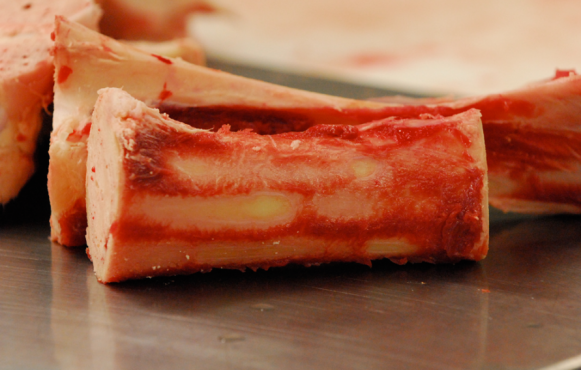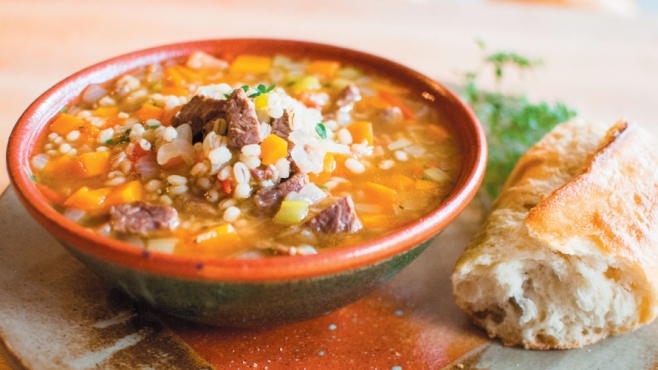Bring Home the Bone Broth
How to make hearty soup in your own kitchen using locally sourced bones
Both broth and stock have been at the center of home cooking for hundreds of years. Broths and stocks are prized for their healing properties as well as general nourishment. By simply simmering meat, vegetables or bones in water, we are able to extract wonderful flavors and nutrients from ingredients that might be otherwise inaccessible.
Broth is a liquid that has been flavored by cooking meat and vegetables. The flavor profile is light and well-seasoned. Often broth is consumed alone or with simple inclusions such as small bits of cooked meat, vegetables and/or grains such as rice or barley. While meat is generally the main flavor agent, sometimes broths can be flavored with vegetables alone. Mushroom broth is one example of a meatless broth that is referenced in many classical recipes. The cooking time for broth (about 2–4 hours) is generally short compared to that of stock or bone broth. This ensures light color and delicate clean flavors. Broth is still very much a liquid when cold.
Stock is a liquid that makes use of the connective tissues found in the joints of animals as well as the subtle flavors of aromatic vegetables. Generally speaking, whole muscle, with the exception of small amounts still attached to the bone, is not used in the production of stock. Depending on the type of bones used in the stock, cooking time varies—45 minutes to an hour for fish, four to six hours for chicken and 10 to 12 hours for veal. The extended cooking time for stock allows for the collagen and elastin found in joint bones to be dissolved in the cooking liquid, resulting in a very high gelatin content. This gelatin provides body and texture to finished soups and sauces. Since stock is used as a foundation ingredient in many recipes its flavor is generally subtle and under-seasoned. This allows the stock to be used in many different applications without contributing too much of its own flavor. Stock sets into a light gelatinous mass when chilled.
Bone broth is a liquid that also makes use of the connective tissues of animals. Ideal bones for bone broth are the joint bones of pork, beef, veal and the back bones of chicken, as these are bones highest in connective tissue. Unlike stock, when making bone broth you are looking for complete extraction of the gelatin contained in the joints. This is achieved by very long cooking times—24 hours for pork, beef and veal, and 12 to 14 hours for chicken. While vegetables and herbs can be added to bone broth to improve flavor, they should be added during the last couple of hours of cooking to prevent total breakdown resulting in an unpleasant grainy texture in the broth. Bone broth can be consumed alone with a bit of seasoning or it can also be used as the basis of soups and sauces. Finished bone broth is cloudy with an almost creamy texture with a sticky finish. Bone broth sets into a very solid gelatinous mass when cold.
Broth vs. Stock vs. Bone Broth
Where to Get Your Bones
When buying bones it is important to specify with the butcher which section of bones you need. Bone broth is best when made with the joints of veal, beef or pork, and the backs and feet of chicken. Bones for marrow applications require the center cuts of long bones. Some butchers will even split the long bone sections lengthwise allowing for easy access to the good stuff (see sidebar). My favorite place to buy bones is Blues Creek Farms Meats in Plain City. Carfagna’s and Weiland’s Market are also great places to get a wide variety of meat products. With a couple of days’ notice, these places can get you just about anything you could want.
The Long Bones While the short joint bones are great for making stock and bone broth, long bones, also known as marrow bones, have their uses, too. Marrow bones can be split lengthwise, or roasted whole, and enjoyed as a truly decadent snack or first course. My favorite way to enjoy long bones is to split marrow bones that have been roasted in a very hot oven (500°) and drizzled with a garlic and fresh parsley vinaigrette, accompanied by crispy sourdough toast points or butter fried French bread slices.







